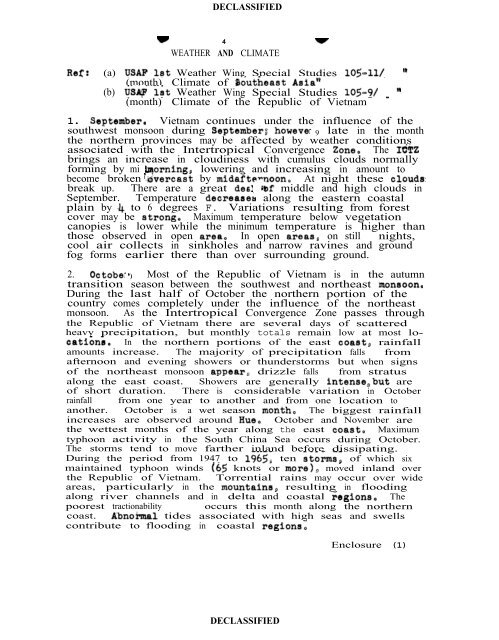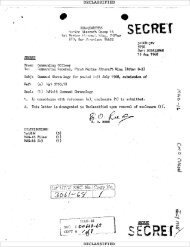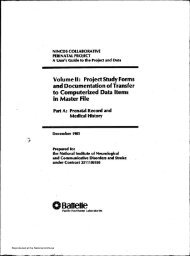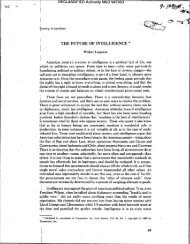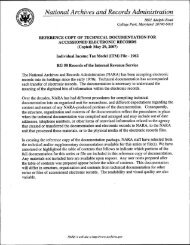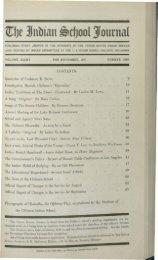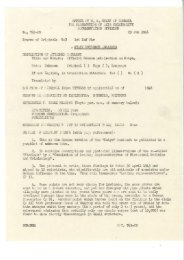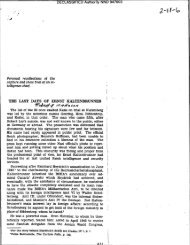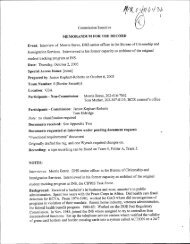I'M - National Archives and Records Administration
I'M - National Archives and Records Administration
I'M - National Archives and Records Administration
Create successful ePaper yourself
Turn your PDF publications into a flip-book with our unique Google optimized e-Paper software.
DECLASSIFIED<br />
1W 4 MV<br />
WEATHER AND CLIMATE<br />
Rer: (a) USAF 1st Weather Wing Special Studies 105-11/ "<br />
(month) Climate of Southeast Asia"<br />
(b) USqF lst Weather Wing Special Studies 105-9/ "<br />
(month) Climate of the Republic of Vietnam -<br />
1. September. Vietnam continues under the influence of the<br />
southwest monsoon during September; however 9 late in the month<br />
the northern provinces may be affected by weather conditions<br />
associated with the Intertropical Convergence Zone. The IOTZ<br />
brings an increase in cloudiness with cumulus clouds normally<br />
forming by mi Porning, lowering <strong>and</strong> increasing in amount to<br />
become broken ,vercast by midafte-noon. At night these cloudsbreak<br />
up. There are a great desa of middle <strong>and</strong> high clouds in<br />
September. Temperature decreases along the eastern coastal<br />
plain by ~4 to 6 degrees F. Variations resulting from forest<br />
cover may be strong. Maximum temperature below vegetation<br />
canopies is lower while the minimum temperature is higher than<br />
those observed in open area. In open areas, on still nights,<br />
cool air collects in sinkholes <strong>and</strong> narrow ravines <strong>and</strong> ground<br />
fog forms earlier there than over surrounding ground.<br />
2. October 0 Most of the Republic of Vietnam is in the autumn<br />
transition season between the southwest <strong>and</strong> northeast monsoon.<br />
During the last half of October the northern portion of the<br />
country comes completely under the influence of the northeast<br />
monsoon. As the Intertropical Convergence Zone passes through<br />
the Republic of Vietnam there are several days of scattered<br />
heavy precipitation, but monthly totals remain low at most locations.<br />
In the northern portions of the east coastp rainfall<br />
amounts increase. The majority of precipitation falls from<br />
afternoon <strong>and</strong> evening showers or thunderstorms but when signs<br />
of the northeast monsoon appear, drizzle falls from stratus<br />
along the east coast. Showers are generally intense.but are<br />
of short duration. There is considerable variation in October<br />
rainfall from one year to another <strong>and</strong> from one location to<br />
another. October is a wet season month, The biggest rainfall<br />
increases are observed around Hue. October <strong>and</strong> November are<br />
the wettest months of the year along the east coast. Maximum<br />
typhoon activity in the South China Sea occurs during October.<br />
The storms tend to move farther inl<strong>and</strong> before dissipating.<br />
During the period from 1947 to 1965, ten storms, of which six<br />
maintained typhoon winds (65 knots or more)p moved inl<strong>and</strong> over<br />
the Republic of Vietnam. Torrential rains may occur over wide<br />
areas, particularly in the mountains, resulting in flooding<br />
along river channels <strong>and</strong> in delta <strong>and</strong> coastal regions. The<br />
poorest tractionability occurs this month along the northern<br />
coast. Abnoimal tides associated with high seas <strong>and</strong> swells<br />
contribute to flooding in coastal regions,<br />
DECLASSIFIED<br />
Enclosure (1)


